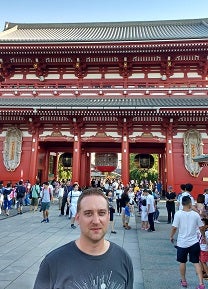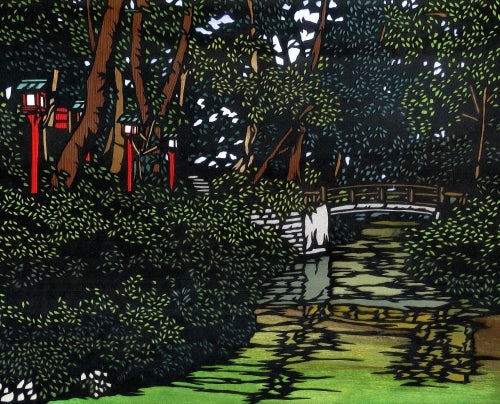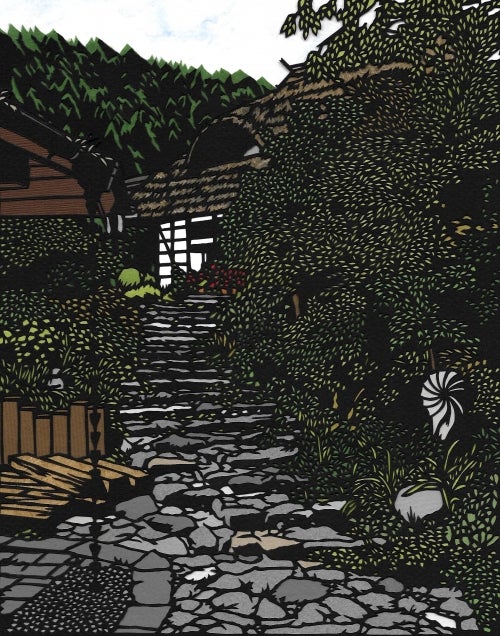 Mark Yungblut (BSW ’04) is a Canadian artist who’s always been intrigued by Japanese art and culture. When Mark enrolled at UWaterloo he had no idea how the East Asian Studies department at Renison University College would impact his goals further down the road. In 2002, he stumbled upon kiri-e (Japanese paper cutting) and since then he’s been expanding this art form throughout Canada, while taking creative liberties to carve out his own niche and find innovative ways to come up with new approaches to his paper cuttings.
Mark Yungblut (BSW ’04) is a Canadian artist who’s always been intrigued by Japanese art and culture. When Mark enrolled at UWaterloo he had no idea how the East Asian Studies department at Renison University College would impact his goals further down the road. In 2002, he stumbled upon kiri-e (Japanese paper cutting) and since then he’s been expanding this art form throughout Canada, while taking creative liberties to carve out his own niche and find innovative ways to come up with new approaches to his paper cuttings.
Alumni Relations had a chance to catch up with Mark to talk about his journey and life after Waterloo.
-----------------------------------------------------------------------------------------------
Can you tell us more about how you were introduced to kiri-e, and what inspired you to continue to pursue this art form?
I was originally introduced to this art form through a stroke of luck, or perhaps fate depending on how you look at it. In high school, I really enjoyed drawing in pencil, and most of my drawings were of Japanese castles and temples. Fast forward a few years to 2002, during a trip to Japan with my wife. While visiting the home of one of her friends, I was showing her my drawings and since her father was an artist, she thought it might be a good idea to show them to him. Her father liked my artwork and thought that I should give paper cutting a try, so he provided me with some materials to take home.
Since then, I’ve grown to love this medium and have been working solely on paper cutting for the past ten years. A major reason why I continued with this art form is the fact that it is unique here in Canada. Most people that see my work have never been exposed to paper cutting, so their interest becomes fairly strong once they realize what they’re looking at. It also allows me to carve out my own niche, and forces me to come up with creative ways to solve problems as I go along.
Would you attribute some of your different approaches, such as your use of colourful paper, to having a multicultural perspective from both your time in Canada, as well as Japan?
Yes, growing up in Canada has definitely given me a different perspective on how to approach this art form. My teacher works strictly in black and white, a style that the majority of his students follow. I think that since East Asia has a history of working in black and white there is an appreciation of that simplicity in Japan, whereas Canadians are much more drawn to color. I also prefer to work in color because it provides me with many more avenues to explore.

What were some memorable experiences from your days at the University of Waterloo that influenced you to get you to where you are today?
I can easily say that the East Asian Studies department played a big role in fostering my interest in Japan. One of the main reasons I chose UWaterloo was its Japanese language program, which obviously helped me communicate while in Japan. If I wasn’t able to hold a basic conversation in Japanese I don’t think I ever would have been able to get started with kiri-e. Apart from the language, the history, culture and religion courses also helped a lot with understanding Japan in greater depth. I think that having a broader understanding of the country has helped shape my continued appreciation and gratitude for having found this art form.
Do you have any future plans in fully pursuing a career in kiri-e? What advice do you have for students or alumni interested in getting into a similar field?
Yes, I’m constantly thinking about how to improve my technique, as well as increasing my exposure to a wider audience. I have a number of goals I’d like to pursue, however having another full time job and two school aged children doesn’t leave a lot of time and money to pursue them fully. My dream is to own a studio where I can sell and teach paper cutting, and earn a living off of that alone. Regardless of what happens, I will always be making new artwork out of a constant desire to improve my skills, as well as the inherent rewards of expressing myself and bringing my visualizations to life.
For me, I’ve found the most important thing has been to keep working on improving my art, and if the product is good, people will naturally be drawn to it. However, one thing that has caught me off guard is how much logistics are involved in getting my artwork out into the world. I’ve gone to a number of shows, art sales, festivals, etc. Some have been really successful, others not as much, but through this experience and my time at UWaterloo I’ve learned to never turn down an opportunity that I haven’t yet experienced. When things are not going according to plan it typically means that there is a problem that needs solving, or that there is another approach I need to try. I’m very stubborn so I eventually manage to push through, but not allowing myself to quit during the bad times has always led to positive outcomes in the end.

What does it mean to you to be a part of an institution celebrating 60 years of innovation? What do you see for the next 60 years at the University of Waterloo?
I pass by UWaterloo fairly often, and it’s amazing to see how quickly it continues to grow. It means a lot to have attended an institution that is so closely connected to the people in this region. I think for the next 60 years it’s important to keep focusing on innovations that are going to bring positive change to the local and global community. Young people typically have a lot of energy and new perspectives, and it’s important to foster and direct that energy towards outcomes that will create change for the better.




